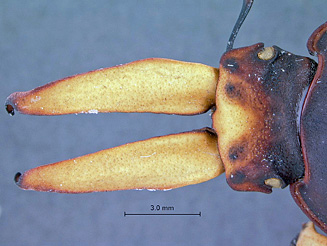|
Colophon primosi
Barnard, 1929
Life > Eukaryotes > Opisthokonta > Metazoa (animals) > Bilateria > Ecdysozoa > Panarthropoda > Tritocerebra > Arthopoda > Mandibulata > Atelocerata > Panhexapoda > Hexapoda > Insecta (insects) > Dicondyla > Pterygota > Metapterygota > Neoptera > Eumetabola > Holometabola > Coleoptera (beetles) > Polyphaga > Superfamily: Scarabaeoidea > Family: Lucanidae > Subfamily: Lucaninae > Genus: Colophon
Found in Seweweekspoort, Swartberg Range. Little is known about its biology but larvae
probably feed on plant roots such as Restioniaceae. Male 28-35mm. Female 22mm.
|
 |
 |
|
Colophon primosi, male. Dorsal view of head and thorax.
[image
M. Cochrane, Iziko
© ] |
Colophon primosi, male. Ventral view of head and thorax.
[image
M. Cochrane, Iziko
© ] |
|
 |
|
|
Colophon primosi. Male genitalia,
parameres only.
I[image
M. Cochrane, Iziko
© ] |
|
Apomorphic species.
Aedeagus
(penis and parameres) are
distinctly asymmetrical, the right paramere is strongly dilated forming a
hook on the inner margin with the anal sternite correspondingly asymmetrical on
the posterior margin; penis well sclerotised (cuticle hardened); anterior
(front) margin of the clypeus raised above the level of the labrum at the suture
(join). Compare genitalia of species groups.
See
male/female images.
This
group includes Colophon
barnardi, Colophon berrisfordi,
Colophon
cassoni, Colophon endroedyi,
Colophon
izardi, Colophon
montisatris, Colophon neli,
Colophon oweni,
Colophon primosi,
Colophon
thunbergi, Colophon
westwoodi and Colophon
whitei.
Publications
Colophon
home
Images and text by Margie Cochrane
|
